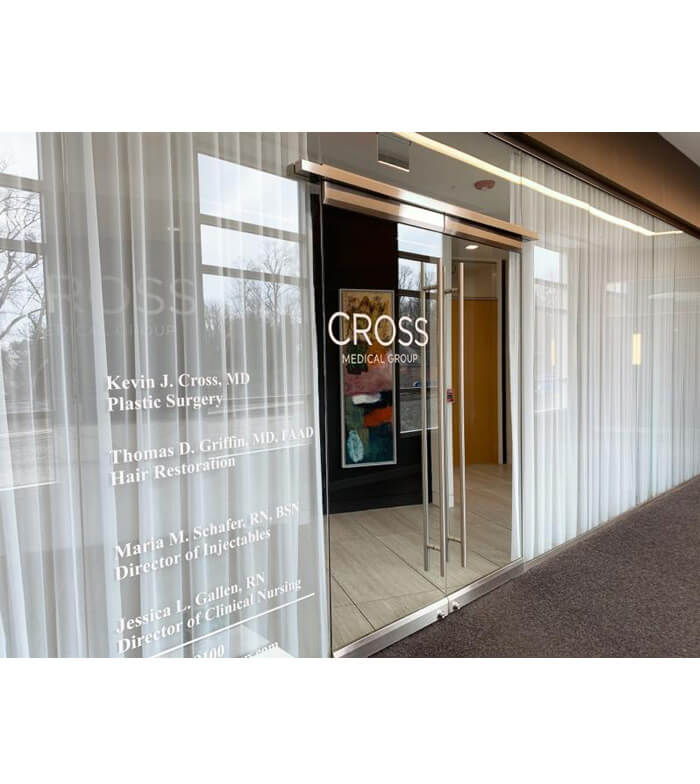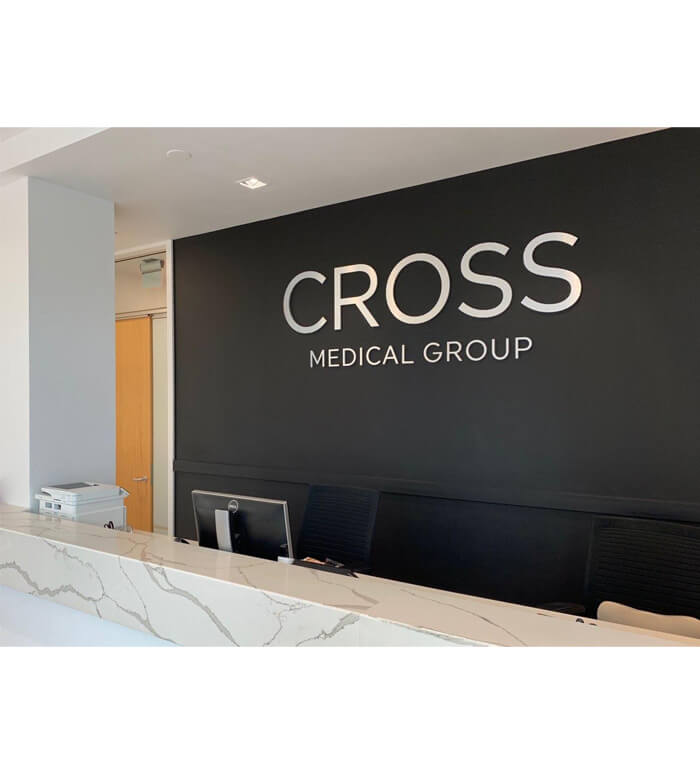Male Hair Transplant
ADDRESSING MALE PATTERN HAIR LOSS WITH PERSONALIZED TREATMENT OPTIONS
CONTENTS
MALE HAIR TRANSPLANT TECHNIQUES
POST-PROCEDURE RECOVERY GUIDELINES FOR A MALE HAIR TRANSPLANT
TIMELINE FOR OPTIMAL RESULTS FROM A MALE HAIR TRANSPLANT
Hair loss in men—particularly due to male pattern baldness—is one of the most common aesthetic concerns that patients bring to Cross Medical Group. The medical term for this genetic condition is androgenetic alopecia. We specialize in male hair transplant strategies at our Philadelphia and Villanova offices that are tailored to the unique pattern and extent of each patient's hair loss.
UNDERSTANDING MALE PATTERN HAIR LOSS
Male pattern baldness affects between fifty and eighty percent of men over the course of their lifetime. The rate of loss and age of onset vary greatly between different populations of people.
The majority of hair loss in men can be attributed to male pattern hair loss, which is referred to as androgenetic alopecia within the medical community. This genetic type of hair loss presents in a typical pattern on the scalp, with the hairline receding from the forehead and balding subsequently occurring on the top of the head. Men experience balding differently, with some only experiencing a receding hairline, while hair loss in others will progress until only a small wreath of hair is left in a semi-circle across the back and sides of the scalp.
The onset and progression of hair loss in men are strongly influenced by hereditary factors, including a sensitivity of certain hair follicles to the hormone dihydrotestosterone (DHT). This sensitivity leads to miniaturization and eventual loss of hair in genetically predisposed areas. Although male hair loss does not pose a medical risk, it can significantly impact self-esteem and confidence.
Several contributing factors may accelerate the process, including stress,
THE CAUSES OF MALE PATTERN HAIR LOSS
Male pattern balding is caused by genetics, which explains why certain populations are more prone to pattern hair loss than others. Researchers have determined that the tendency to inherit the condition can come from either side of the family. If your father's or mother’s family experienced pattern baldness, then you are likely to experience some degree of it as well. The exact cause of pattern baldness is only starting to be understood, but researchers have determined that it is caused by an inherited sensitivity of some follicles to the effects of the hormone dihydrotestosterone (DHT) in certain areas of the scalp. Several genes are involved, which explains the variation in pattern, severity and onset of hair loss among family members.
CONNECT WITH US
To learn more about a male hair transplant at the Philadelphia and Villanova offices of Cross Medical Group, call (215) 561-9100, or submit a contact form to request an appointment.
HAIR LOSS SOLUTIONS FOR MEN
While hair loss is not a condition that requires medical treatment, many men are justifiably concerned about balding. While it’s normal for older men to have thinner hair and areas of baldness, younger men may feel that hair loss ages them prematurely or detracts from their overall appearance. Hair loss can be detrimental to one’s self-image and self-esteem, so it’s understandable that many people wish to slow or reverse the effects of male pattern baldness.
MALE HAIR TRANSPLANT BASICS
The most effective solution for male pattern baldness is a combination of medical treatment for the maintenance of one’s current hair and hair transplant surgery to replace lost follicles. There are several hair transplant techniques available, but they al l involve moving hair from one area of the head (the donor area, which is DHT resistant) to an area of baldness. Men who suffer from male pattern baldness typically have hair on the sides or back of the head that never falls out. This donor hair is used to repopulate balding areas of the head.
When performed correctly, transplanted hair should remain in place indefinitely, making hair transplantation a permanent solution to male pattern baldness. A skilled surgeon who specializes in hair transplant surgery will be able to implant the hair so that it blends naturally with the surrounding area and fits with the patient’s natural hairline and hair density.
The skin is the layer of the scalp anatomy that contains the mechanism responsible for manufacturing hair: the follicle.
MALE HAIR TRANSPLANT TECHNIQUES
Male hair transplants have been performed for several decades, but the techniques involved in transplant surgery have evolved in recent years to make it a more natural and effective treatment for male pattern baldness. Cross Medical Group will decide which procedure is best for a hair transplant patient. Most often, FUE is performed because of its ability to cause less scarring and harvest more grafts. We strive to achieve excellent coverage, density, and a cosmetically natural result. In some cases, a second male hair transplant is required to fill in any tiny gap between the grafts. This can be done usually one year later if desired by the patient. The grafts begin to grow three to four months after surgery, and the final result occurs nine to twelve months after the hair transplant procedure.
The techniques most commonly used in male hair transplants include strip harvesting and follicular unit excision (FUE), both of which result in follicular units for transplantation:
FOLLICULAR UNIT EXCISION
In a follicular unit excision (FUE) male hair transplant, a small punch instrument creates precise circular incisions around individual follicular units, which are then extracted from the donor area. These tiny sites heal within about a week, and the harvested units are transplanted into thinning or balding areas for natural-looking coverage. The FUE male hair transplant method causes minimal trauma to the donor site, leaves little visible scarring, and is ideal for men who prefer shorter hairstyles.
STRIP HARVESTING
The traditional form of harvesting hair for transplantation, strip harvesting or follicular unit transplantation (FUT), involves the removal of elongated strips of skin and hair from the donor site, which is located in the back or on the sides of the scalp. The donor site is then sutured closed to allow for healing. The strip is dissected, and individual follicular units are transplanted into the balding areas. Strip harvesting results in a horizontal scar in the donor site, which is easily hidden by surrounding hair.
It should be understood that one needs to wear one’s hair at least a half-inch long to hide the scar. Strip harvesting is a good procedure for patients who are not good candidates for FUE. Patients with weak follicles or soft, thin skin, such as older men, do better with strip harvesting than with FUE. In addition, the donor area hair can be left long for the procedure, which some hair transplant patients may desire for work appearances.

Age is an important factor in planning a successful male hair transplant. Younger patients may still be experiencing an evolving pattern of hair loss, which can make long-term planning more challenging. Ideal candidates for male hair transplants are typically over the age of twenty-five, when the pattern of hair loss becomes more stable. Older patients can still benefit greatly from hair transplants, especially when managed with a strategic, long-term view.
Hair characteristics such as thickness, color, curl, and density also influence the visual results of a hair transplant. Thicker hair provides more coverage, while curly or wavy hair often offers better cosmetic density. Our team evaluates all these factors during your male hair transplant consultation to determine the best approach for optimal outcomes.
At Cross Medical Group, patients are advised to refrain from strenuous activities and exercise for at least one week to minimize the risk of bleeding or trauma to both the donor and transplant sites. It is common for the scalp to feel tender or sensitive for several days, and this typically resolves within the first week. Some male hair transplant patients may also experience mild swelling on the forehead or around the eyes, which usually subsides on its own.
Most individuals should allow about one week for initial healing from a hair transplant. During this time, small scabs will form around the newly placed follicles—these should be left undisturbed to ensure optimal graft survival. Male hair transplant patients may choose to discreetly cover the scalp with a hat or scarf during recovery. Protecting the treated area from direct sunlight is critical in the weeks and months following male hair transplant surgery to reduce the risk of discoloration. Once the scalp has healed, patients are encouraged to use sunscreen or wear a cap when outdoors to maintain healthy skin and hair growth.
After the male hair transplant surgery, the transplanted hair will often shed within two to three weeks, and new hair growth from the new follicles will begin within a few months.
Full results from a male hair transplant are usually visible within nine to twelve months. In the months following surgery, transplanted hairs go through a natural shedding phase before new growth begins.
When performed by an experienced surgeon, the results of a hair transplant should appear very natural. It takes a surgeon with a very artistic eye to perform a male hair transplant well, as each hair follicle must be individually placed in the scalp in a precise way to replicate the patient’s natural hair line.
The results of a male hair transplant are permanent, but several sessions may be required to attain the desired results. To maintain results, patients should follow all post-operative care guidelines and attend follow-up appointments.
MORE HAIR RESTORATION OPTIONS
Male hair transplants aren't limited to the scalp. At Cross Medical Group, we also provide tailored solutions for men experiencing patchy or thinning facial hair. Beard transplants use the same follicular unit extraction and implantation techniques to enhance density, define facial contours, or fill in sparse areas. These procedures are especially beneficial for men who struggle to grow facial hair due to genetics, scarring, or previous injuries.
Eyebrow transplants for men are becoming increasingly popular as well. The delicate nature of eyebrow design requires a meticulous and artistic approach. Cross Medical Group prioritizes natural-looking results that frame the face and complement each patient's unique features.
Not all previous hair restoration procedures meet patient expectations. At Cross Medical Group, corrective hair transplants are available for men seeking to address unnatural hairlines, visible scarring, or poor density from earlier surgeries performed at other practices.
For those not ready for hair transplant surgery—or seeking to enhance surgical outcomes—we offer a range of non-surgical solutions. Collagen induction therapy stimulates natural growth factors in the scalp, strengthening follicles and supporting regrowth. Medications such as finasteride and minoxidil remain trusted options for slowing hair loss, while targeted topical supplements nourish the scalp. Low-level laser therapy improves circulation and cellular energy within hair follicles, and exosome treatments deliver regenerative signals that can rejuvenate dormant follicles.
SCHEDULE A CONSULTATION
For more advice about a male hair transplant at the Philadelphia and Villanova offices of Cross Medical Group, call (215) 561-9100, or submit a contact form to request a consultation.








